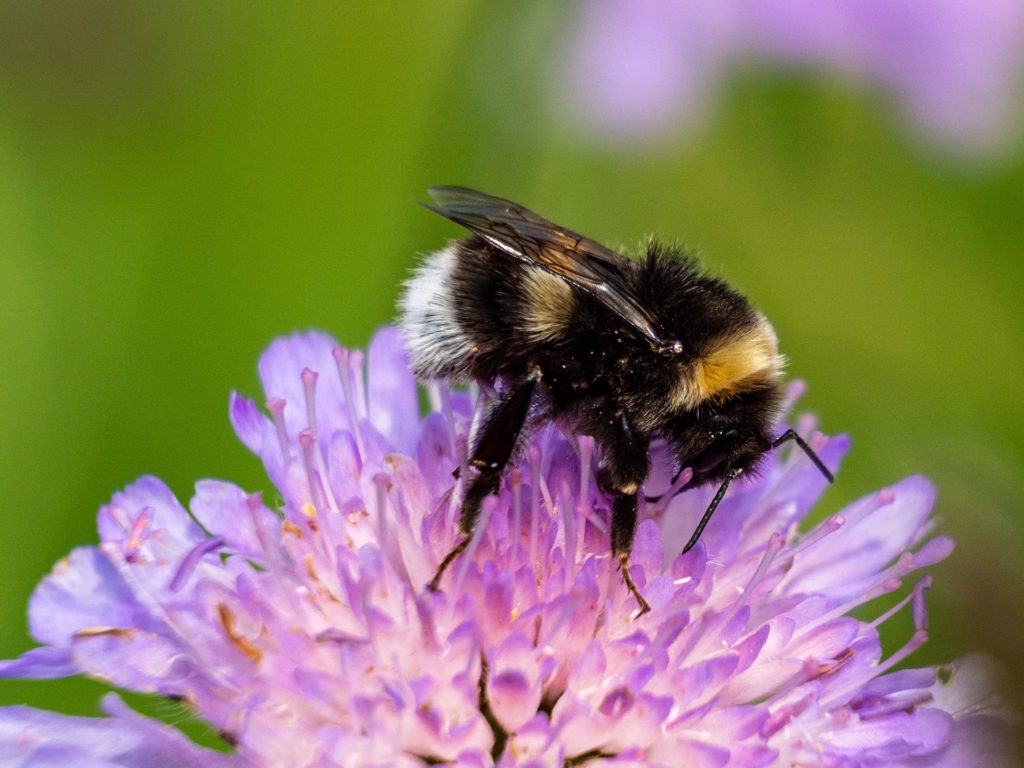After a long warm fall, the weather has finally cooled down. If you’ve been out visiting the last flowers in your garden you may have seen some of the last of the pollinators visiting them. Most likely they were bumble bees. They are the most cold tolerant of all the bees and so they will be the first you’ll see of the season and the last.
I’ve always loved bumble bees—they’re just so cute and fuzzy.
There are some 250 species of bumble bee in the world and less than 50 species native to North America. And they may be our strongest and most important pollinators around.
Bumble bees are strong pollinators
One thing that makes them good pollinators is that they can tolerate colder temperatures than other bees. This is due to a couple of features they have. Their many hairs give them more insulation. And they can uncouple their wings and use their flying muscles (yes, bee muscles!) to vibrate to heat their bodies up. Tolerating colder temperatures means they can be out foraging for nectar and pollen over a longer season.
They’ve been found to be faster workers than honey bees, visiting up to twice as many flowers as honeybees.
Flowers of many important plants require buzz pollination. The flowers of some important plants, such as tomatoes, peppers, eggplants, and blueberries, and many other crop plants, hold onto pollen and need to be physically shaken out of the anthers (the pollen producing plant organ). Only some bees know how to shake the anthers, bumble bees are of the few. They get into the flower and buzz their flight muscles to free up the pollen. The pollen sticks to the bee’s hairs and gets moved into another flower to cross pollinate it.
So if you’re getting low fruit set in your garden, perhaps you should pay attention to your bumble bee population. For pollination services many farmers prefer bumble bees because they pollinate more thoroughly. The result of more thorough pollination is quicker fruit set and more and larger fruit. Commercially available bumble bees have become big business for lately for berries, peppers, and hothouse tomatoes.
They’re social like the honey bee
We all hear about the amazing social organization in the honey bee hives. And many of our native bees are solitary animals. The bumble bee is social but to a lesser extent than the honey bee.
Life starts for a queen bumble bee at the end of the warm season. Along with her sisters, she emerges from her mother’s nest, mates, then immediately searches for a good spot to hibernate for the winter. Suitable spots for hibernating may be in cool compost piles, wood piles, loose garden soil, or leaves on the ground.
When she comes out in the early spring she searches for pollen and nectar to feed on, then searches for a good place to build a nest. Often this place would be in a shady, north-facing spot, an abandoned rodent hole, in the ground. She likes to line it with grass bits or moss.
Once all set up she continues foraging for food to bring back to her nest. Then she lays her eggs. And she sits on them, like a bird. She’ll go back out for more food if necessary. When these eggs hatch she has a crop of worker bees. They are all female, like the worker honey bees.
Now the queen can stay in her nest and have her offspring do all the work. She focuses next on creating the next generation of her species. The next batch of eggs she lays will be males and young queens. The worker bees bring in the food they need and tend to housekeeping and defending the nest.
When the males hatch, they go out to find mates. And when the new queens hatch, they go out, mate, and then find their hibernating spot. The mother queen and all the workers die and the nest is empty. The males mate and die right away.
So every year is a new batch of bumble bees, unlike honey bees whose queen lives for several years.
Bumble bees need our help like all the other pollinators
Bumble bees are on the decline like almost all the other pollinators. Their demise is from the usual factors; pesticides, habitat destruction from agriculture and urbanization, and even introduced diseases from managed bee hives.
Start to think about enhancing your garden and landscape to provide for bees. Bumble bees can use a wide variety of flowers for food, so if you can, fit in more flowers. I’ll provide a lot more details on flowering plants that are good for bees before spring arrives. Meanwhile a good resource is bumblebeeconservation.org to get you started.
Try not to keep a super tidy garden. Leaves, logs and old mouse homes can provide bumble bees with wintering spots and nest spaces.
You can actually make a nest to encourage bumble bees to use. See bumblebeeconservation.org/bumblebee-nests/ for simple instructions.
The new queen bumble bees are mostly into their hibernation for the winter, impregnated with next year’s crop of her species. Watch for them when they come out in late winter to early spring. The best magnet for them I have noticed is manzanita flowers. When they bloom, take a nice close look and see how many different kinds there are! They are the new queens preparing their nests.
Here’s a weird little fact about me. I always wish I could pet a bumble bee, they’re just so fuzzy! So every fall I end up coming across a few dead bees on the ground. I figure it must be a male or a worker bee that’s done, or maybe even a deceased queen. So I’ll pick it up and gently rub it’s hairs across my lips. Lips have a lot of nerve endings so we can feel more with them than our fingers. They are indeed so soft! Try it!

